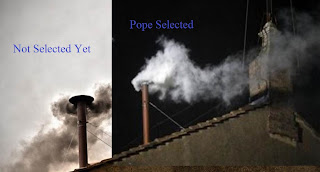Few days ago Hindu people celebrated their "Shivaratri" festival. Part of the celebration involved thousands of "babas" (including some non-babas) smoking marijuana (ganja in Nepali). Majority of the scientific community believes on the bad part of this smoke on humans. In this post, however, I am talking about another holy smoke that came out from the holy chimney at the Vatican signaling the selection of the new pope.
Interesting part of new pope selection process is that the way public are informed. Black smoke means no pope has been elected (selected) and white smoke means new pope has been selected. This is strange to me. But this tradition goes back to hundreds of years. This tradition is still alive. How does the Vatican produce distinct color smoke?
Black smoke was produced by burning ballot, potassium perchlorate (KClO4), anthracene (C14H10), and sulfur (used as fuel). KClO4 is an inorganic salt and is a strong oxidizer potentially used to react with organic molecules, most commonly, in fireworks and explosive primers. Anthracene is a polycyclic aromatic hydrocarbon (PAH) consisting of three fused benzene rings. It is a component of coal tar (we know when someone burns coal tar it only gives black smoke).
White smoke was produced by burning potassium chlorate (KClO3), milk sugar and pine rosin. Potassium chlorate is similar to perchlorate in terms of its oxidizing ability. Milk sugar was used as an easily ignitable fuel). Rosin must have contributed mainly to producing white smoke.
The key difference between black and white smoke production is the source of carbon. Difference between anthracene and rosin.
It is always good to keep your tradition alive, however, should think about some creative ways of doing it in modern era. Burning above mentioned chemicals either for black or for white smoke produces some "bad" chemicals into the air.
Watch this nice video about the black and white smoke.
The key difference between black and white smoke production is the source of carbon. Difference between anthracene and rosin.
It is always good to keep your tradition alive, however, should think about some creative ways of doing it in modern era. Burning above mentioned chemicals either for black or for white smoke produces some "bad" chemicals into the air.
Watch this nice video about the black and white smoke.









No comments:
Post a Comment